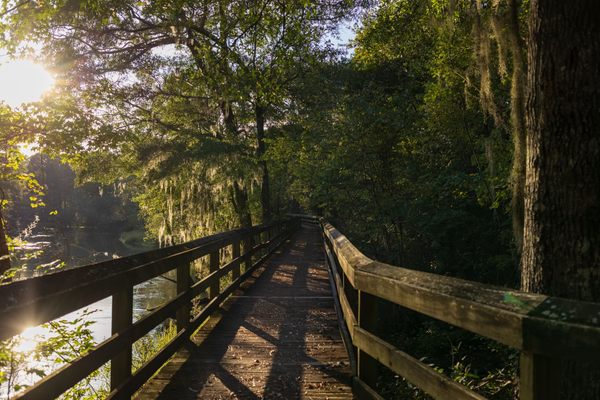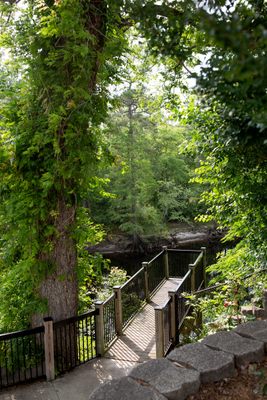About
The Lumber River covers four counties with 115 miles of rolling curves. It has been beloved by the people of North Carolina for centuries. More recently, the federal government designated 81 miles of the Lumber a National Wild and Scenic River. This wonder of water is easily accessible through Lumberton’s Riverwalk, a three-mile paved pathway.
To understand why this wild river is so wild, you need to take a closer look. The waters of the Lumber River look a little murky, but it’s not because of pollution. Like the Amazon, the Lumber is a blackwater river. Its dark, reddish color comes from the soil and plants on the riverbed. And because it is fed by Coastal Plain swamps (about 90 percent of the waters in the river are from swamps), lots of decaying matter mixes in with the water.
Despite, or maybe because of, its unique composition, the Lumber River is a popular attraction for tourists and locals alike, who flock to its waters and banks for canoeing, hiking, hunting, and camping.
The Lumber River is also an area of interest for historians. The river was an important part of life for the state’s earliest inhabitants, Indigenous people such as the Chowanoc, Roanoke, and Catawba tribes, and the Lumbee tribe, who take their name from this majestic river. Over the centuries, the river and its swamps have “provided fish, game, medicinal plants—and cover for Indigenous people resisting colonization.” Beneath the dark, rich soil of the river, lie remnants of the past. There have been discoveries of dugout canoes, pottery, and tools, among others.
The river has also yielded discoveries of fossilized plants and animals. According to the Lumber River Conservancy, “A diverse number of species of fossilized plants and animals ranging from a few thousand to millions of years old can be seen on the State’s river banks and exposed geologic areas.” But as North Carolina anthropologist Stan Knick told The Assembly, “You don’t take a bunch of pottery with you when you go hunting or fishing.” In short, if you find something, take only pictures and memories.
Know Before You Go
There are two points of entry for those looking to get on the river—Princess Ann and Chalk Banks— which are located about an hour from each other. Both sites have camping facilities, and reservations are required. Boats, rafts, and canoes are prohibited within designated swimming areas.
The Lumberton Riverwalk is located in Downtown Lumberton, and is a short, paved trail along the river bank open from sunrise to sunset.
Published
March 1, 2024
Sources
- https://www.lumberton-nc.com/river-walk-bike-trail-at-luther-britt-park/
- https://files.nc.gov/deqee/documents/files/lumber-river-basin.pdf
- https://www.theassemblync.com/environment/the-contested-swamps-of-robeson-county/
- https://files.nc.gov/deqee/documents/files/lumber-river-basin.pdf
- https://medium.com/ncculture-kids/lumber-river-state-park-especially-unique-black-water-f21c9125c8bb
- https://www.lumberriverconservancy.org/the-lumber-river/














